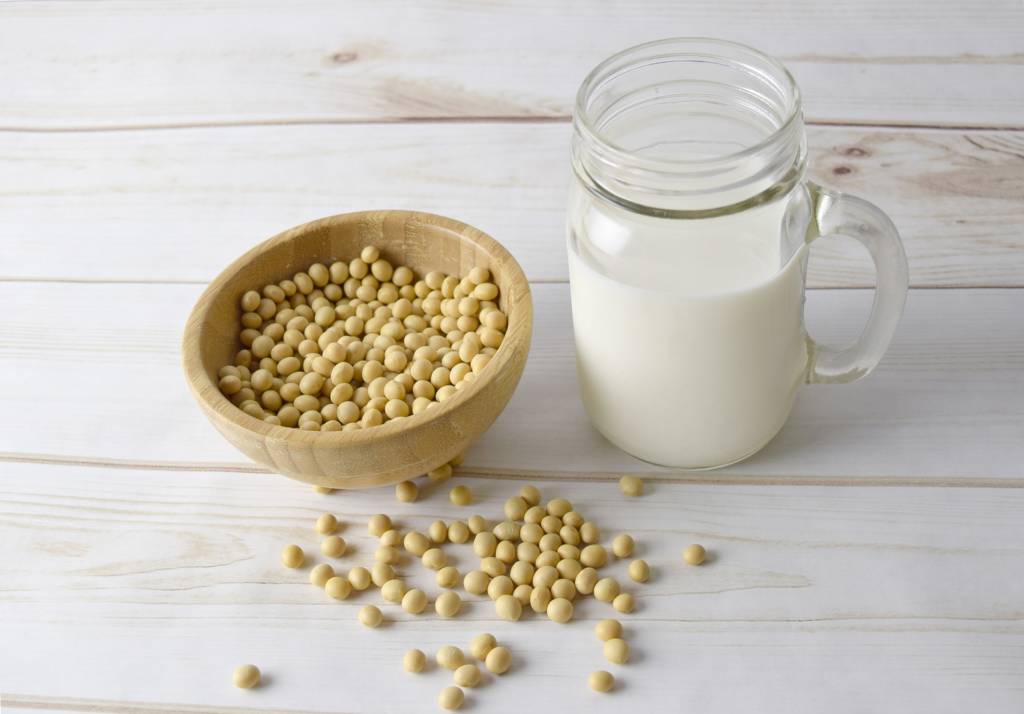
In a global market burgeoning with plant-based milk, soy milk stands apart due to the combination of its nutrition profile, potential health benefits, sustainability, and versatility. Among U.S. consumers, food and beverage choices are now interconnected with emotional and mental wellbeing. Additionally, 35% say their buying decisions are influenced by climate-friendliness of the product.[1] U.S.-grown soy adheres to the U.S. Soy Sustainability Assurance Protocol (SSAP), based on a national system of sustainability and conservation laws and regulations. The nation’s 500,000 soybean farmers also implement best production practices.[2]
Consumers whose purchases are motivated by emotional well-being seek benefits such as relaxation, cognition, and stress release. Products with consumer appeal may also incorporate nutrients that can promote healthy aging.[3] There is evidence that soy foods can reduce risk of coronary heart disease,[4] and a recent study in China concluded that more frequent consumption of soy products was associated with a lower risk of depression.[5]
Soy foods, including soy milk, provide many approaches for meeting a variety of consumer demands. For example, 47% of Australian consumers value health benefits like heart and immune support in their food and drinks. Thai consumers appreciate versatility, with 54% finding value in food or drinks that can be utilized in various recipes.[6] Soy foods include shelf-stable unsweetened soy milk that can easily be incorporated into beverages, soups, sauces, desserts, snacks and baked goods.
Soy Milk is a Well-Researched Nutrition Star
Because plant proteins vary in their nutritional quality, consumers focusing on plant versus animal proteins should be aware of the differences when planning their diet.[7] In addition to offering all nine essential amino acids, soybeans are a uniquely rich source of isoflavones that have been studied for decades for their association with preventing chronic disease as well as offering heart health benefits.
Among plant proteins, soy is the only one comparable in quality to animal protein.[8] In a recent comparison of 27 plant-based milks and two cow’s milk samples, the energy and nutrient intakes were calculated and compared with dietary reference values for Germany, Austria and Switzerland. With the exceptions of dairy milk and soy drinks that each provide at least 3% protein, most milk alternatives contained 1% protein or less.[9] The 2020-2025 USDA Dietary Guidelines for Americans specifically include soy-based products in the dairy category.[10]
Soy Milk Can Satisfy Consumer Cravings
Global consumers are prioritizing their health by seeking products that contribute to their wellbeing and offer quality and value. Approximately 45% of Indian consumers and 71% of Chinese consumers gravitate toward dietary choices that support their mental and physical health over other approaches. Consumers in the U.S., Brazil, Australia, China, South Africa and New Zealand want nutrient-dense, affordable food and beverages, with nutritional value being a top priority.[11]
Similarly, nearly 75% of U.S. foodservice operators report an increased customer interest in better-for-you beverage offerings. Overall, a nearly 15% sales growth for cold beverages last year outpaced hot beverage growth.[12] Consumers have a choice of trending flavors and combinations such as ube (purple yam) milkshakes; dragonfruit, passionfruit and other tropical fruits in cocktails and smoothies; and creamy chilled coffee or tea drinks made with fruit, flavorings and their choice of milk.
Innovative Soy Milk Applications
Sustainable U.S. Soy is well positioned with today’s beverage trends. An aging global population—projected to reach 2 billion by 2050—is helping to drive the demand for food and drinks that support mental wellness. In Thailand, mental wellness is increasingly a priority for nearly half of the consumers, especially the Gen X age group. Demand is growing for food and drink products that support both physical and mental health.[13] Soy milk has the potential to help satisfy those demands.
Fewer than 20% of Chinese consumers say they currently have plant-based protein beverages daily, while 40% say they purchase milk or dairy products every day. More than half of consumers report being interested in trying drinks with multiple plant-proteins.[14] Examples of new beverage products include soy inspired combinations such as herbal tea with plant-based milk (including soy), a grape juice and soy drink (muscat-flavored soy milk), and a soy latte incorporating green vegetables.
Chilled specialties on summer U.S. restaurant menus include flavored cold brew coffee concoctions with a choice of plant-based milk; a variety of nondairy milkshakes; beverages combining passionfruit or dragonfruit juices and fruit syrups with dairy or nondairy milk; and matcha or green tea shakes and smoothies made with plant-based ice creams. The versatility of soy milk offers a variety of opportunities for innovative foodservice and retail drink products targeting wellness-conscious consumers
#
This article was (partially) funded by the United Soybean Board.
[1] International Food Information Council. 2023 Food & Health Survey, 23 May 2023.
[2] U.S. Soybean Export Council. U.S. Soy Sustainability Assurance Protocol (SSAP) 2022. https://ussec.org/resources/u-s-soy-sustainability-assurance-protocol-ssap-2022/
[3] Mintel: Supporting mental health through food and drinks, June 15, 2023. https://www.mintel.com/food-and-drink-market-news/supporting-mental-health-through-food-and-drinks/
[4] Mark Messina. Soy and Health Update: Evaluation of the Clinical and Epidemiologic Literature. Nutrients. Dec. 8, 2016.
[5] Tao Zhang, Guojun Jiang, et al. “Soy product consumption and the risk of major depressive disorder in older adults: Evidence from a cohort study.” Frontiers in Psychiatry, September 2, 2022. https://www.frontiersin.org/articles/10.3389/fpsyt.2022.888667/full
[6] Mintel. “Resilient Consumption Fuels Breakthroughs in Healthy Aging, Nutrition and Agriculture.” June 28, 2023.
[7] Hertzler, Stephen; Lieblein, Jacqueline C., et al. “Plant Proteins: Assessing Their Nutritional Quality and Effects on Health and Physical Function.” Nutrients. December 2020. https://www.ncbi.nlm.nih.gov/pmc/articles/PMC7760812/
[8] United Soybean Board. “Soyfoods.” https://www.unitedsoybean.org/issue-briefs/soyfoods/
[9] Walther, Barbara; Guggisberg, Dominik, et al. “Comparison of Nutritional Composition between plant-based drinks and cow’s milk.” Frontiers in Nutrition, 28 October 2022, Sec. Food Chemistry, Volume 9 – 2022.
[10] USDA. Dietary Guidelines for Americans. https://www.dietaryguidelines.gov
[11] Mintel. “Resilient Consumption Fuels Breakthroughs in Healthy Aging, Nutrition and Agriculture.” June 28, 2023. https://www.mintel.com/food-and-drink-market-news/resilient-consumption-fuels-breakthroughs-in-healthy-ageing-nutrition-and-agriculture/
[12] Technomic. “Technomic Study Reveals Beverage Category Performance Shifts.” Press Release. May 2023.
[13] Mintel: Supporting mental health through food and drinks June 15, 2023. https://www.mintel.com/food-and-drink-market-news/supporting-mental-health-through-food-and-drinks/
[14] Mintel. “Plant Based Beverage Opportunities in China.” April 6, 2023 https://www.mintel.com/food-and-drink-market-news/plant-based-drinks-offer-opportunities-for-the-chinese-market/
